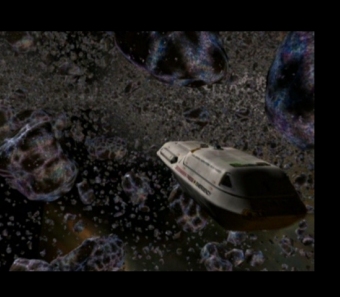|

In Star Trek, a radiogenic particle is a type of
radioactive particle, found in low concentrations in space and in
higher concentrations associated with various natural or artificial
phenomena. Radiogenic particles in sufficient quantities can serve as
an alternate power source for starships, though this is only safe with
a properly modified conversion matrix. (VOY: "Dragon's Teeth")
Class T clusters, such as the one explored by the Delta
Flyer in 2376, contain radiogenic sources. After the Flyer was damaged
by an encounter with a dark matter lifeform, Captain Kathryn Janeway
took the Flyer into a radiogenic ring around a class T planet, hoping
to reinitialize the warp reaction by beaming particles directly into
the reaction chamber. However, the approach of more dark matter
lifeforms forced her to ignite a chain reaction in the rings instead,
using the Flyer's phasers. (VOY: "Good Shepherd"). In 2377, Lieutenant
Reginald Barclay speculated that a radiogenic field might be preventing
his datastream from reaching Voyager. (VOY: "Inside Man").
In real science, the term radiogenic refers to any
substance that is produced by a process of radioactive decay. Lead is
perhaps the best example of a radiogenic substance, as it is produced
from the radioactive decay of uranium and thorium. Specifically, Pb-206
is formed from U-238, Pb-207 from U-235, and Pb-208 from Th-232. Other
substances considered radiogenic are argon-40, formed from radioactive
potassium, and nitrogen-14, which is formed by the decay of carbon-14.
U-238, U-235, and Th-232 themselves are likely to be radiogenic as
well, being formed from the decay of those nuclei of the elements
heavier than uranium which do not undergo spontaneous fission, just
after they were formed in stellar supernovae. Other important examples
of radiogenic elements are radon and helium, both of which form during
the decay of heavier elements in bedrock. The global supply of helium
is radiogenic.
Radiogenic isotopes form some of the most important
scientific tools used today in radiometric dating or as an isotopic
tracer in isotope geochemistry.
|
|
